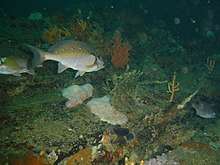|
Chirodactylus brachydactylus
 Chirodactylus brachydactylus, the twotone fingerfin, is a species of marine fish in the fingerfin (morwongs) family (family Cheilodactylidae) of order Perciformes. It is native to the coast of southern Africa.[1][2] DistributionAlong the coast of southern Africa from Walvis Bay to Maputo.[1] Subtropical, between 23°S and 36°S in eastern Atlantic and western Indian oceans.[3] DescriptionBody colour basically brown, paler on ventral side, with a brighter white area below the eyes in the front part of the body, and a row of five white spots along the lateral line. Juveniles are silvery with orange anal and paired fins. Colour changes to adult colouration from about 5 cm. The fish has fleshy lips around a small mouth. Length up to 40 cm, weight up to 3 kg. Matures at 25 cm, and spawns in summer.[1][4][5] Habitat and ecologyRocky reefs and sandy areas near reefs at depths to 240 m. Juveniles may be found in rock pools.[1] C. brachydactylus is a small-benthic-invertebrate predator, There is some dietary overlap between the species assembages of the reef predators, in which this fish occurs, but each appears to have a dietary niche which reduces interspecific competition for food.[6] Its diet includes crabs, anphipods, bivalves and other invertebrates.[4] C. brachydactylis is preyed upon by large reef predators, including the santer seabream, (Cheimerius nufar), red steenbras (Petrus rupestris), scotsman (Polysteganus praeorbitalis), and yellowbelly rockcod (Epinephelus marginatus).[7] Importance to humansDoes not often take a hook, but relatively easily caught spearfishing.[1] Conservation statusNot evaluated. [3] References
|
||||||||||||||||||||||||||
